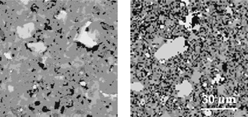Crossref Citations
This article has been cited by the following publications. This list is generated based on data provided by
Crossref.
Thomas, Jeffrey J.
Biernacki, Joseph J.
Bullard, Jeffrey W.
Bishnoi, Shashank
Dolado, Jorge S.
Scherer, George W.
and
Luttge, Andreas
2011.
Modeling and simulation of cement hydration kinetics and microstructure development.
Cement and Concrete Research,
Vol. 41,
Issue. 12,
p.
1257.
Jennings, Hamlin M.
and
Bullard, Jeffrey W.
2011.
From electrons to infrastructure: Engineering concrete from the bottom up.
Cement and Concrete Research,
Vol. 41,
Issue. 7,
p.
727.
Kumar, Aditya
Reed, Jason
Sant, Gaurav
and
Biernacki, J.
2013.
Vertical Scanning Interferometry: A New Method to Measure the Dissolution Dynamics of Cementitious Minerals.
Journal of the American Ceramic Society,
Vol. 96,
Issue. 9,
p.
2766.
Feng, Pan
Miao, Changwen
and
Bullard, Jeffrey W.
2014.
A model of phase stability, microstructure and properties during leaching of portland cement binders.
Cement and Concrete Composites,
Vol. 49,
Issue. ,
p.
9.
Lu, Yang
and
Garboczi, Edward J.
2014.
Bridging the Gap between Random Microstructure and 3D Meshing.
Journal of Computing in Civil Engineering,
Vol. 28,
Issue. 3,
Valentini, Luca
Parisatto, Matteo
Russo, Vincenzo
Ferrari, Giorgio
Bullard, Jeffrey W.
Angel, Ross J.
Dalconi, Maria C.
and
Artioli, Gilberto
2014.
Simulation of the hydration kinetics and elastic moduli of cement mortars by microstructural modelling.
Cement and Concrete Composites,
Vol. 52,
Issue. ,
p.
54.
Feng, Pan
Garboczi, Edward J.
Miao, Changwen
and
Bullard, Jeffrey W.
2015.
Microstructural origins of cement paste degradation by external sulfate attack.
Construction and Building Materials,
Vol. 96,
Issue. ,
p.
391.
Li, X.
and
Grasley, Z. C.
2015.
Shrinkage and Creep Caused by Dissolution.
p.
318.
Maruyama, Ippei
and
Igarashi, Go
2015.
Numerical Approach towards Aging Management of Concrete Structures: Material Strength Evaluation in a Massive Concrete Structure under One-Sided Heating.
Journal of Advanced Concrete Technology,
Vol. 13,
Issue. 11,
p.
500.
Li, X.
Grasley, Z.C.
Bullard, J.W.
and
Garboczi, E.J.
2015.
Computing the time evolution of the apparent viscoelastic/viscoplastic Poisson’s ratio of hydrating cement paste.
Cement and Concrete Composites,
Vol. 56,
Issue. ,
p.
121.
Li, X.
Grasley, Z.C.
Garboczi, E.J.
and
Bullard, J.W.
2015.
Modeling the apparent and intrinsic viscoelastic relaxation of hydrating cement paste.
Cement and Concrete Composites,
Vol. 55,
Issue. ,
p.
322.
Stroh, J.
Schlegel, M.-C.
Schmidt, W.
Thi, Y. Nguyen
Meng, B.
and
Emmerling, F.
2016.
Time-resolved in situ investigation of Portland cement hydration influenced by chemical admixtures.
Construction and Building Materials,
Vol. 106,
Issue. ,
p.
18.
Li, X.
Rahman, S.
and
Grasley, Z. C.
2016.
Challenges in Mechanics of Time Dependent Materials, Volume 2.
p.
73.
Li, Xiaodan
Rahman, Syeda
and
Grasley, Zachary C.
2016.
Computationally implemented modeling of creep of composite materials caused by phase dissolution.
Computational Materials Science,
Vol. 125,
Issue. ,
p.
61.
Biernacki, Joseph J.
Bullard, Jeffrey W.
Sant, Gaurav
Brown, Kevin
Glasser, Fredrik P.
Jones, Scott
Ley, Tyler
Livingston, Richard
Nicoleau, Luc
Olek, Jan
Sanchez, Florence
Shahsavari, Rouzbeh
Stutzman, Paul E.
Sobolev, Konstantine
and
Prater, Tracie
2017.
Cements in the 21st century: Challenges, perspectives, and opportunities.
Journal of the American Ceramic Society,
Vol. 100,
Issue. 7,
p.
2746.
Li, Xiaodan
Grasley, Zachary C.
Bullard, Jeffrey W.
and
Garboczi, Edward J.
2017.
Irreversible desiccation shrinkage of cement paste caused by cement grain dissolution and hydrate precipitation.
Materials and Structures,
Vol. 50,
Issue. 2,
Li, X.
Grasley, Z.C.
Garboczi, E.J.
and
Bullard, J.W.
2017.
Simulation of the influence of intrinsic C-S-H aging on time-dependent relaxation of hydrating cement paste.
Construction and Building Materials,
Vol. 157,
Issue. ,
p.
1024.
Moradian, Masoud
Hu, Qinang
Aboustait, Mohammed
Ley, M. Tyler
Hanan, Jay C.
Xiao, Xianghui
Scherer, George W.
and
Zhang, Zhidong
2017.
Direct observation of void evolution during cement hydration.
Materials & Design,
Vol. 136,
Issue. ,
p.
137.
Feng, Pan
Bullard, Jeffrey W
Garboczi, Edward J
and
Miao, Changwen
2017.
A multiscale microstructure model of cement paste sulfate attack by crystallization pressure.
Modelling and Simulation in Materials Science and Engineering,
Vol. 25,
Issue. 6,
p.
065013.
Li, Xiaodan
Grasley, Zachary C.
Bullard, Jeffrey W.
and
Feng, Pan
2018.
Creep and relaxation of cement paste caused by stress‐induced dissolution of hydrated solid components.
Journal of the American Ceramic Society,
Vol. 101,
Issue. 9,
p.
4237.
